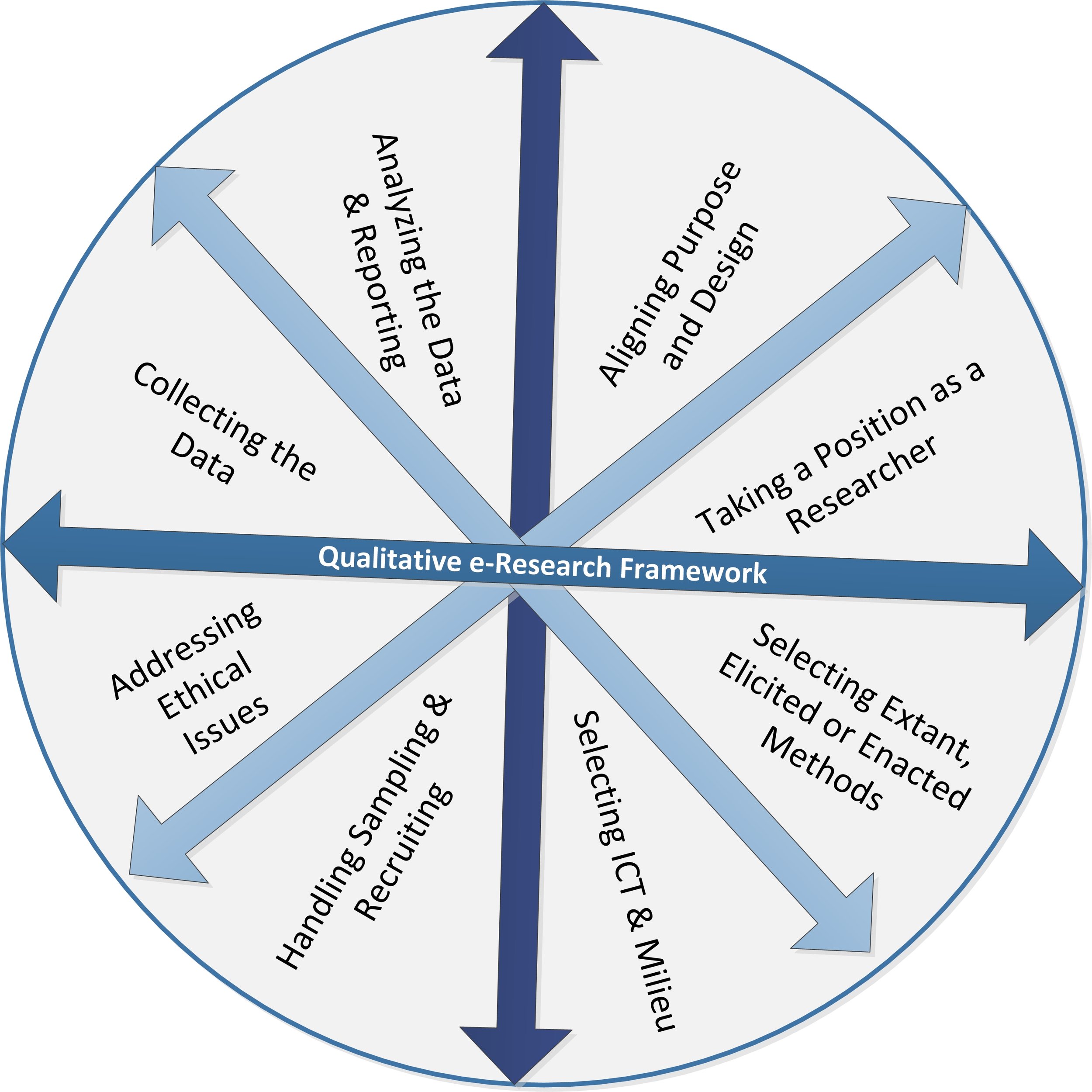Digital Methods for Social Research: OA Articles
By Janet Salmons, PhD
Dr. Salmons is the author of Doing Qualitative Research Online, and Gather Your Data Online. Use the code COMMUNIT24 for 25% off through December 31, 2024 if you purchase research books from Sage.
What are Digital Methods?
While some types of online research use communication tools to interact with remote participants, digital methods use online approaches to study online phenomena. Chao et al (2024) describe digital methods:
Since the mid-2000s, a particular outlook on studying ‘natively digital’ objects using digital data for research has formed under the label of ‘digital methods’ (Rogers, 2013). This label denotes a media research approach that takes the data, the technical specifications and functionality of digital media – may these be webpages, blogs, wikis, web archives or social media, and users’ links, likes, posts or comments, to name only a few – to study both the social and the media.
Jensen et al (2023) define their approach to digital methods as “scalable reading,” combining computational approaches with more traditional ways of simply reading textual data. Jensen (2022) similarly advocates “zigzagging” between digital and traditional ethnographic methods.
We call our analytical approach a “scalable reading.” Scalable reading is a combination of close and distant reading, two terms we borrow from Moretti (2000) to describe two methodological approaches: traditional (close) direct textual reading where the researcher engages with every page individually (in our case, a single tweet) and distant reading which is aggregated reading of many texts at once assisted by a computer.
Vardouli et al (2024) use “methods of digital history from the broad field of the digital humanities” by “drawing from methods such as topic modeling and network analysis in digital history, we advance an approach to querying the database and activating it for historical inquiry.”
These researchers’ explanations show that there is no one way to define digital methods! Read this collection of open-access articles from across disciplines to discover the creative qualitative and quantitative variations that can be used to study online behaviors and the tools and practices used to work and plan in a digital world.
Burkey, B. (2022). From Bricks to Clicks: How Digital Heritage Initiatives Create a New Ecosystem for Cultural Heritage and Collective Remembering. Journal of Communication Inquiry, 46(2), 185-205. https://doi.org/10.1177/01968599211041112
Abstract. ‘Cultural heritage institutions, such as museums, libraries, archives, and historical societies, are increasingly using digital heritage initiatives and social media platforms to connect and interact with their heritage communities. This creates a new memory ecosystem whereby heritage communities are invited to contribute, participate with, and share more of what they are interested in collectively remembering, rather than simply accepting the authoritative narratives of heritage institutions, which raises questions about what this means for cultural heritage writ large and whose versions of the past these heritage communities will hold onto as their digital inheritance. The primary contributions of this article are to provide both an extended view of the issue by building on several qualitative studies involving in-depth interviews and digital observations with eight cultural heritage communities over a five-year period and to better understand how their digital heritage initiatives are creating a new ecosystem for cultural heritage and collective remembering.
Chao, J., van Geenen, D., Gerlitz, C., & van der Vlist, F. N. (2024). Digital methods for sensory media research: Toolmaking as a critical technical practice. Convergence, 0(0). https://doi.org/10.1177/13548565241226791
Abstract. ‘Digital methods’ turn to medium-specific and online avenues for social and cultural research. While these approaches foster empirical media studies, it has become increasingly challenging to ‘follow the medium’ and ‘repurpose’ its methods. The prominence of sensory media such as ‘smart’ networked devices (e.g. mobile phones) in mundane practices and their infrastructural dependencies confront media scholars with highly contingent objects of study. Yet, studying such sensor-based devices is crucial, for they enable continuous and unnoticed monitoring of everyday (inter)activity. The article suggests that developing digital methods for sensory media can be understood as specific ‘critical technical practice’ (CTP) by engaging with two toolmaking stories. It draws on and emphasises the fundamental similarity between CTP and digital methods which both aim at conjoining technical engagement and understanding with methodological reflection. The toolmaking stories explicate the making of and the limitations to developing digital methods for increasingly obfuscated mobile sensory media, exploring the possibilities of repurposing their functionality and data. They include building tools for app code analysis focused on apps’ capacity to track sensor data, as well as for ‘sensing’ and analysing network traffic of mobile devices in use. The featured toolmaking then unravels distinctive research affordances, that is, action possibilities for ‘static’ and ‘dynamic’ modes of analysis grappling with the technicity of mobile sensory media and their data. We argue that toolmaking as CTP for sensory media studies implies engaging with these media as entangled infrastructures, examining not just their social, but also their technical ‘multi-situatedness’. This involves investigating the ‘liveliness’ of their data, or how it is generated, processed and made sense of. In conclusion, we discuss implications for ‘doing digital methods’ in sensory media research. Toolmaking itself becomes an inevitable form of media research and critique, inviting and challenging researchers to deploy the media’s situatedness for their investigations.
Coromina, Ò., Tsinovoi, A., & Munk, A. K. (2023). Digital marketing as digital methods: Repurposing Google Ads for controversy mapping. Big Data & Society, 10(2). https://doi.org/10.1177/20539517231216955
Abstract. Digital advertising is central to the business models and technological affordances of digital platforms, creating marketplaces for user attention. Despite the keen theoretical attention to the commodification of audiences in critical new media and data studies, there has been little exploration of how digital marketing can also be understood as a methodological lens to study both controversies and the practices involved in the commodification of attention around the issues that animate such controversies. Addressing this gap in knowledge by drawing on the digital methods approach, this article proposes repurposing the tools, data and practices of digital marketing – what we coin digital marketing epistemology – as new methodological points of observation in controversy mapping. Focusing empirically on Google Ads, we scrutinize the building blocks of advertising campaigns on the platform and their metrics and measurements. We then offer a set of methodological ‘recipes’ for repurposing the Google Ads platform for controversy mapping and illustrate through a series of data sprints how this can contribute not only to a better understanding of the measurement and valuation practices that are involved in converting attention into a tradable asset but also the role these practices play in the unfolding of techno-social controversies.
Friese, C. (2023). Situational Analysis and Digital Methods. Forum Qualitative Sozialforschung Forum: Qualitative Social Research, 24(2). https://doi.org/10.17169/fqs-24.2.4078
Abstract. In this paper, I reflect upon the methodological implications of digitization and digital methods for situational analysis. I carefully read Noortje MARRES's argument for and development of what she called situational analytics. I ask how her proposal would be incorporated within a situational analysis project of digitization and funerals. I develop a provisional research design, as a kind of thought experiment, weaving my reflections on situational analysis and digital methods through an autoethnographic account of mourning in the enforced digital of the COVID-19 pandemic. I conclude with the argument that such digital methods are necessary for situational analysis to reckon with, and yet also pose a risk of erasing the embodied and affective elements of a situation. I contend that the poiesis of ethnographic research—where mediated and embodied interactions qua situations are experienced and written into language, and writing forms a necessary but always also impossible task—remains rooted in bodies and affects that are always also elements in situational analysis. We cannot lose track of those elements that also defy the digitized elements of any given situation.
Hansson, K. (2023). visual methods for desire and wonder in the digital heritage. Feminist Review, 135(1), 162-180. https://doi.org/10.1177/01417789231201860
Abstract. The digitalisation of cultural heritage creates expectations for improved research methods and more diverse and inclusive memory institutions. However, it is difficult to take advantage of the opportunities the quantification might give owing to deficient and inadequate metadata. The diversity of standards and wilfulness in different historical archive practices creates problems when aggregating data from various sources. The ambition to create more diverse and inclusive memory institutions, compensating for the historical lack of justice, also creates the risk of excluding important contexts from the digital collections. To develop research methods that take this archival wilfulness into account, in this study I have used speculative design to explore images from Europeana, the digital archive that aggregates data from memory institutions all over Europe. Instead of seeing this archive as something lacking in terms of shared standards and inclusive vocabularies, I suggest we see Europeana as a queer collection of wilful archival practices, by showing the desires and imaginations represented in the archival context. By contrasting the visual content of an image with the metadata that describes the image, the norms and desires in the archival practice come into focus, as the metadata points out what at the time was considered interesting about an image, and the reason the photograph was taken. Images described as ‘Swedes’, for example, rarely show pictures of Swedes in Sweden. Swedes are described as Swedes when they are outside Sweden. It is the exotic and foreign that are categorised. Most importantly, the person who controls the camera is not in the picture, but the choice of perspective and the metadata description of the image tell us something about the photographer’s and archivist’s will and desires. By visually reversing the perspective and making visible both norms and deviations, I show how one can approach this digital heritage with a methodology of feminist wonder.
Jensen, H. S., Jensen, J. M., Thygesen, A. U., & Pedersen, M. O. (2023). Digital methods in memory studies: A beginner’s guide to scalable reading of Twitter data. Memory Studies, 0(0). https://doi.org/10.1177/17506980231197126
Abstract. This article makes a methodological contribution to the growing subfield of digital memory studies. It demonstrates a possible way forward for memory studies scholars who want to try out digital methods but also remain in conversation with the kinds of research traditionally produced within the field. The article revolves around a showcase of an analytical workflow for conducting a scalable reading of large quantities of tweets through access to the Twitter API. The article argues that using only basic computational approaches to social media data in combination with API access can drastically improve data collection practices and enrich analytical practices, producing results recognizable and compatible with existing research in memory studies. As a case study, the article uses a dataset of nearly 200,000 tweets collected around two events that prompted Twitter users to discuss the history of the American children’s television program Sesame Street. It does so to demonstrate: first, how a visualization focusing on chronology can help underpin arguments about heightened activity around certain events. Second, a close reading of selected tweets from these events can support claims of shared activity, even if no hashtags were used. And third, how using simple tools for distant reading makes it possible to converse with questions and issues about gatekeepers and connectivity already central within memory studies. Furthermore, the article demonstrates how the Twitter API supports a more systematical, large-scale collection of tweets than usually seen in memory studies, making researchers less dependent on the algorithmic bias that rules the search in the platform’s regular interface.
Jensen, T. E. (2022). The Slalom Method: How to zig-zag between digital methods and traditional methods in ethnography. Qualitative Research, 0(0). https://doi.org/10.1177/14687941221138405
Abstract. The increasing availability of digital resources is an opportunity as well as a challenge for ethnographers who seek to incorporate ‘the digital’ into their field studies. This article is an attempt to reflect on the peculiar nature of new digital resources, their relation to conventional method integration problems, and the practical opportunities for making the digital relevant to ethnographic field studies. These reflections are grounded in the authors’ trials and tribulations during an ethnographic project, in which a deliberate attempt was made to combine digital methods with traditional ethnographic methods. This involved wrestling with a series of methodological issues, which were eventually managed by developing an approach called the slalom method. The slalom method consists of a series of rules and heuristics that together constitutes a pragmatic strategy for facilitating the integration of digital resources into the iterative and reflexive process of an ethnographic field study.
Koed Madsen, A. (2023). Digital methods as ‘experimental a priori’ – how to navigate vague empirical situations as an operationalist pragmatist. Convergence, 0(0). https://doi.org/10.1177/13548565221144260
Abstract. Digitalisation and computation presents us with a vague empirical world that unsettles established links between measurements and values. As more and more actors use digital media to produce data about aspects of the world they deem important, new possibilities for inscribing their lives emerge. The practical work with digital methods thus often involves the production of social visibilities that are misfits in the context of established data practices. In this paper I argue that this dissonance carries the distinct critical potential to design data experiments that (a) uses the act of operationalisation as an engine for creating intersubjective clarity about the meaning of existing concepts and (b) takes advantage of algorithmic techniques to provoke a reassessment of some of the core assumptions that shape the way we pose empirical problems are normally framed. Drawing on the work of Kant, Peirce, Dewey and C.I. Lewis I propose to think of this critical potential as the possibility to practice what I term 'experimental a priori' and I use qualitative vignettes from two years of data experiments with GEHL architects to illustrate what this entails in practice. Faced with the task of using traces from Facebook as an empirical source to produce a map of urban political diversity, the architects found themselves in a need to revisit inherited assumptions about the ontology of urban space and the way it can even be formulated as a problem of diversity. While I describe this as a form of obstructive data practice that is afforded by digital methods, I also argue that it cannot be realised without deliberate design interventions. I therefore end the paper by outlining five design principles that can productively guide collective work with digital methods. These principles contribute to recent work within digital STS on the recalibration of problem spaces and the design of data sprints. However, the concept of ‘experimental a priori’ can also serve as a philosophical foundation for knowledge production within computational humanities more broadly.
Pink, S. (2022). Methods for Researching Automated Futures. Qualitative Inquiry, 28(7), 747-753. https://doi.org/10.1177/10778004221096845
Abstract. Emerging digital, automated and connected systems, devices, data, and algorithms are increasingly part of our lives. They participate in the everyday realities of participants in qualitative research and they are embedded in the infrastructures through which we research and share our scholarship, research, and practice. This article introduces this new landscape and its implications for qualitative research. I argue that we need to engage not only with questions of how automated futures are imagined by others, but with how to engage with such futures as qualitative researchers.
Pink, S. (2022). Design Anthropological Filmmaking for Automated Futures. Qualitative Inquiry, 28(7), 781-797. https://doi.org/10.1177/10778004221097060
Abstract. In this article I introduce the theory and practice of Design Anthropological Filmmaking as a mode of actively proposing alternative possibilities to the technological solutionist narratives and imaginaries that dominate industry, government and policy narratives about automated futures. I argue for documentary practice that is theoretically and critically aligned with a vision of the world as ongoingly emergent, and unfinished, and contests conventional innovation paradigms. To demonstrate this theory-practice dialogue I draw on my collaborative documentaries Laundry Lives and Smart Homes for Seniors which explore everyday life in the home with digital, emerging and automated technologies.
Vardouli T, Leblanc M, Pertigkiozoglou E. The design methods meshwork: Activating the Design Methods Group Newsletter through digital history. International Journal of Architectural Computing. 2024;0(0). doi:10.1177/14780771231220903
Abstract. This article elaborates a computationally enabled approach to the study of design methods in 1960s North America. This entails the construction, visualization, and analysis of a digital database built from entries of the Design Methods Group Newsletter, a periodical published monthly between 1966-71. The article proposes a workflow that combines methods such as topic modeling and network visualization to activate the Newsletter as a source of anecdotal and informal knowledge, and to enable histories of connectivity and transaction that may elude archival investigations on singular actors or institutions. In doing so, the article contributes arguments and techniques for the study of design methods as a complex social, technical, and intellectual meshwork. The meshwork brings discursive themes, techniques, actors, and institutions at the same level of investigation and allows for layered cartographies of the field that advanced the systematic study of design and ushered in the development of early computer applications.































The wealth of material available online is irresistible to social researchers who are trying to understand contemporary experiences, perspectives, and events. The ethical collection and -use of such material is anything but straightforward. Find open-access articles that explore different approaches.